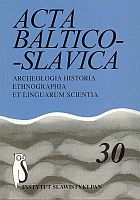Взаимоотношeния балтийских и славянских языков в свeтe ономастичeских исслeдований
Relation Between Slavic and Baltic Languages in the Light of Onomastic Research
Author(s): Juozas JurkenasSubject(s): Language and Literature Studies
Published by: Instytut Slawistyki Polskiej Akademii Nauk
Keywords: onomastic; hydronyms; Baltic languages; Slavic languages
Summary/Abstract: The article is an attempt to compare results of some fundamental onomastic studies with some hypotheses on this problem. On the basis of an analysis of hydronyms Ch. Kraz concludes that in the territories which were once occupied by German, Celtic, Italian (with Venedian), Illyrian and Baltic tribes there the so-called ‘Old-European’ hydronyms, common in form and the nature of their origin W.P. Schmid calls attention to the fact that these old hydronyms, found in different parts of Europe, almost as a rule have equivalents in the Baltic areas. The Polish linguist Tadeusz Milewski divides archaic anthroponimic systems into two groups – the Eastern baga and Western teutā. To the teutā group he classifies also German, Celtic, Illyrian and Baltic anthroponomical systems. Accordingly, what Milewski marks with the symbol teutā, in Ch. Krauze’s terminology is termed the Old European onomastic community. An analysis of onomastic material studied by the above mentioned scholars thus supports an argument confirming the hypothesis proposed by V. Pisani and J.W. Otkupszczikow. The Slavic languages have been shaped on the basis of dialects closely resembling the Baltic ones. A group of dialects that would become the Baltic dialects, situated in a periphery, might have completely fossilized and preserved many archaic features (= elements of ”old European” type). In the territories that would become the Slavic territories changes were more dynamic. A big role was played here by the Iranian element (= peculiarities of the baga group).
Journal: Acta Baltico Slavica
- Issue Year: 2006
- Issue No: 30
- Page Range: 261-267
- Page Count: 7
- Language: Russian

